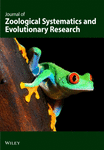An interpretation of the sex cells and the early development in sponges, with a note on the terms acrocoel and spongocoel
Abstract
Summary
Recent investigations convincingly establish that the choanocyte is one of the principal cell types of sponges.
The spermatozoon and the egg can be derived from choanocytes also in terms of orientation of the cell and function of certain cell surface areas. The idea that different functional properties are bound to certain surface areas of this cell may be used to elaborate some aspects of previous morphological reconstructions.
The cleavages can be interpreted also as the distribution of different areas of the original egg surface to those of certain cells in the embryo. Following this point of view, it becomes evident that, although sponge embryos have à typical vegetative part, they never develop à true entoderm. Movements of gastrulation appear comparable to those in other phyla, but the invaginated parts are soon re-evaginated. Concludingly, the ectoderm is the only functional layer in most Porifera. The interior elements and the choanocyte chambers are equivalents to the primary mesenchyme. Two types of metamorphosis are recognized within the Porifera:
1. Acrocoelic development, where an apical (anterior end of larva) invagination - acrocoel -gives rise to the choanocyte chambers and most of the interior structures, and where the excurrent canal system is only faintly developed, if at all.
2. Acroccelic-spongocoelic development where, besides the apical invagination, an ab-apical (posterior end of larva) invagination appears, to which we restrict the term “spongocoel”. In these cases, the acrocoel gives rise to the choanocyte chambers, while the spongocoel is the origin of the excurrent canal system. The spongocoelic invagination is the second cavity formed through invagination in the ab-apical area, and is not to be confused with the first, transient gastrulation.
Zusammenfassung
Eine Interpretation der Gescblechtszellen und der Friihentwicklung von Schwämmen mit Bemerkungen über die Begriffe Acrozoel und Spongozoel
Neuere Untersuchungen haben iiberzeugend erwiesen, daß die Choanocyte einer der basalen Zellentypen der Spongien ist. Das Spermatozoon und das Ei konnen beide strukturell aus Choanocyten abgeleitet werden hinsiditlich der Orientierung der Zelle und der Funktionen gewisser Areale der Zellenoberflache. Die Erkenntnis, daß verschiedene funktionelle Eigen-schaften an bestimmte Oberflachenareale gebunden sind, mag audi dazu benutzt werden, einige Aspekte der hiesigen morphologischen Rekonstruktionen bei den Spongien abzuschatzen.
Man kann audi die ersten Teilungen der Zygote als eine Zuweisung bestimmter Zellen-oberflachen der Eier an verschiedenen Tochterzellen betrachten. Folgen wir dieser Betrachtungs-weise, wird es klar, daß - obwohl die Spongien ein typisch vegetatives Hinterende besitzen -sie doch kein wirkliches Entoderm entwickeln. Die Gastrulationsbewegungen gehen wie in anderen Metazoen vor sich, aber die eingestülpten Partien werden sehr bald wieder evaginiert. Wir sdiließen daraus, daß nur das Ektoderm als fungierende Hautschicht in den Poriferen anwesend ist. Die inneren Elemente und Choanocytenkammern sind Aquivalente zum prima-ren Mesenchym in anderen Metazoen.
Zwei wesensverschiedene Entwicklungsformen sind bei den Schwammen auseinanderzu-halten:
1. Die acrozoele Entwicklung mit einer apikalen Einstülpung (also beim Vorderende der schwimmenden Larve). Aus diesem Acrozoel entwickeln sich die Choanocytenkammern und die meisten inneren Strukturen. Das ausfuhrende Kanalsystem ist sehr schwadi oder gar nicht entwickelt.
2. Die Acrozoel/Spongozoele Entwicklung mit zuerst einer apikalen Einstulpung und ein wenig spater einer anderen ab-apikalen (zu welch letzteren wir die Bezeichnung “Spon-gozoel” begrenzen). In diesen Fällen gibt das Acrozoel Ursprung zu den Choanocytenkammern, während die ausführenden Kanäle aus dem Spongozoel entstehen. Die spongozoele Einstulpung ist die zweite am ab-apikalen (vegetativen) Pol und ist von der ersten, im kurzdauernden Gastrulastadium, streng zu unterscheiden.




